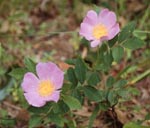
 |
"Fields and hillsides were covered with blue and purple and rose-colored flowers." - from Barbara Cooney's Miss Rumphius |
|
| Pasture Rose (Rosa carolina) |
Plants are usually the first thing that come to our minds when we think of prairie. Prairie plants are the basis for the prairie ecosystem for several reasons.
Plants absorb and convert energy from the sun into nutrients they use to grow, flower, and seed. These nutrients then get passed along the food chain of prairies to insects, rodents, birds, and other animals that eat the plants.
Plants help maintain the diversity of the prairie ecosystem, attracting animals who use the prairie for food and habitat.
Prairie plants have adapted to this specific environment with structures that help them survive. Some of these structures are leaves and stems, flowers, and root systems. By examining a prairie plant closely, you can find parts of the plant that make it able to live in its environmental conditions.
|
|
Copyright © 2000 Illinois State Museum